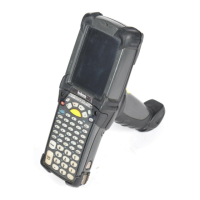8 - 6 MC909X Integrator Guide
7. Push the battery to fully re-insert it in the mobile computer. One audible click can be heard as the battery is fully
inserted.
8. On the MC9090-G, press and hold the trigger.
or
On the MC909X-K or MC909X-S, press and hold the left scan button.
9. Connect the mobile computer to AC power using the CAM or insert the mobile computer into a powered cradle.
10. The Update Loader application first looks for a file on a storage card. If it does not find it, it looks in the \temp
directory.
When it finds the appropriate file, it loads the package onto the mobile computer. A progress bar displays until
the update completes.
11. The mobile computer re-boots.
12. The calibration screen appears.
Creating a Splash Screen
Use a bitmap file to create a customized splash screens for the mobile computer. Use Image Update with a bitmap
file, rather than a package file, to update the splash screen.
To create a custom splash screen:
1. Create a .bmp file using a graphic program with the following specifications:
•
Size: 240 x 296.
•
Colors: 8 bits per pixel (256 colors) for color displays.
2. Modify the bitmap file and save.
To load the splash screen on the mobile computer:
1. Create a text file named pkgs.lst which contains the name of the bmp file. For example, mysplash.bmp.
2. Copy the bmp file and the pkgs.lst file to one of the following:
•
SD card root directory
•
mobile computer’s \temp directory
•
mobile computer’s \Windows directory.
3. If using an SD card, insert the SD card into the mobile computer.
4. Perform a cold boot.
5. Press the trigger or side scan button for 5 seconds while booting to invoke the Update Loader and install the
splash screen.
NOTE When initiating an update via a boot sequence, the update loader looks for updates first on the root of an
installed SD card and then in the \temp folder on the mobile computer’s persistent storage volume. A
response file, pkgs.lst, indicates which files to update. In most cases, Symbol provides this pkgs.lst file with
the update and you should only modify it when updating a splash screen partition. See Creating a Splash
Screen for more information.

